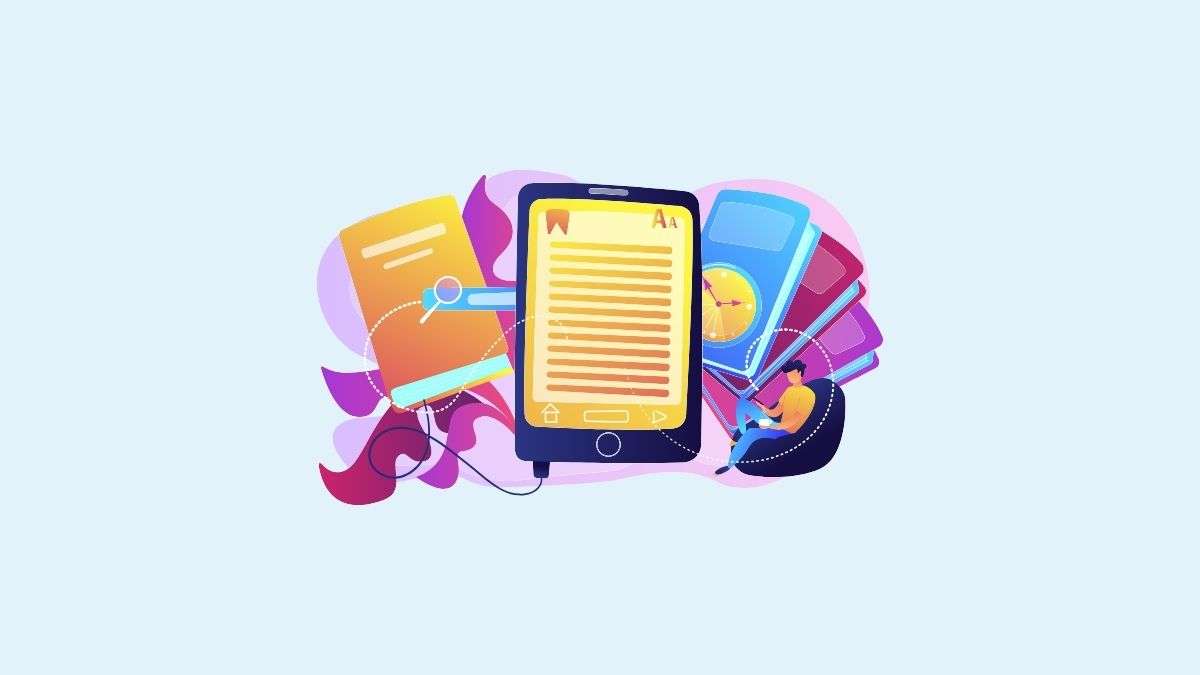Table of Contents
- Introduction
- The Advantages of Ebooks in the Digital Library
- The Changing Landscape of Publishing and Reading
- Embracing Innovation: Technology and the Future of Ebooks
- Conclusion – Navigating the Exciting Future of Ebooks
Introduction
Libraries have undergone a remarkable transformation in the digital age, offering us a glimpse of an exciting future of ebooks. Traditional brick-and-mortar libraries with rows of physical books and periodicals have evolved into vast digital libraries offering instant access to millions of ebooks, journals, videos, and more. This shift has made a world of information available at our fingertips.
Ebooks, in particular, have exploded in popularity as digital reading devices like e-readers, tablets, and smartphones have become ubiquitous. Future Market Insights‘ recent projections indicate that the global ebook market is poised to expand at a compound annual growth rate (CAGR) of 4.9% from 2022 to 2032, potentially reaching a value of USD$32.19 billion by 2032. This growth underscores the significant potential of ebooks to revolutionize reading and publishing in the 21st century.
Digital libraries powered by the Internet have reshaped how we discover and interact with content. Hyperlinked text allows readers to jump to helpful background information seamlessly. Search algorithms help surface relevant sources from massive digital archives. Readers can highlight passages, make digital notes, share favorite quotes, and more. The reading experience has become more personalized, social, and empowering.
The Evolution of Traditional Libraries to Digital Libraries
Traditional libraries were limited by the physical space available to house printed books and periodicals. Accessing this information required traveling to the library itself. Today, digital libraries have removed these physical constraints. Storage space is no longer an issue since digital archives can grow exponentially at little cost. Readers can now access library resources remotely from a laptop or mobile device.
The Growing Popularity and Impact of Ebooks in the Digital Age
Ebooks have risen dramatically in popularity thanks to the proliferation of smartphones, tablets, e-readers, and apps. These portable digital devices allow readers to carry entire libraries in their pocket and read books anywhere. Ebooks are also more affordable and environmentally friendly, offering searchability and highlighting features.
As ebooks become more common, the publishing industry is shifting to focus more on digital distribution. More authors are self-publishing ebooks, and traditional publishers face diminishing print sales. While print books are still popular, ebooks dominate growth in book sales today.
How Digital Libraries are Reshaping Content Access
Digital libraries facilitate instant access to books, academic journals, newspapers, magazines, and more from any Internet-connected device. This removes geographical and physical barriers, allowing broader access to information. Readers can search vast archives to discover relevant content.
Digital texts also enable new interactive reading experiences. Hyperlinked terms provide instant contextual information. Social features let readers discuss passages with others. Multimedia integration brings books to life. AI can deliver personalized recommendations to enhance how we discover and absorb information. The digital library ecosystem continues to evolve and rapidly enhance our intellectual lives.
The Advantages of Ebooks in the Digital Library
Ebooks provide unprecedented accessibility and convenience when it comes to reading material. With just an Internet connection and a device like a smartphone, tablet, or e-reader, readers can instantly access millions of ebook titles from anywhere. This level of accessibility opens up new opportunities for reading on the go, whether commuting, traveling, or curled up in bed.
It also enables access to niche, hard-to-find, or out-of-print titles that readers would likely not find at their local library or bookstore. No longer constrained by business hours, physical locations, or availability, readers can browse, sample, and download ebooks 24/7. This convenience and expanded access allows more people to enjoy reading as a hobby.
Interactive Features
Unlike their print counterparts, ebooks open up exciting interactive and multimedia content possibilities. Many ebooks now integrate video, audio, 3D images, games, quizzes, and more that bring stories and information to life. Readers can also easily highlight passages, take notes, and annotate directly in ebooks across devices.
Some platforms even enable readers to share these annotations and highlights with friends reading the same ebook title, allowing for collaborative analysis and discussion. With customizable fonts, layouts, and accessibility features, ebooks can be fine-tuned to particular reading preferences or needs. As technology progresses, we can expect ebooks to become more immersive and engaging experiences.
One of the most practical advantages of ebooks is that they take up no physical space and use minimal paper. A single e-reader can store thousands of ebook files without adding clutter at home. For libraries and bookstores, this space-saving design also offers a wider selection of titles since shelf space and storage capacity are no longer limiting factors.
From an environmental standpoint, the paperless nature of digital reading reduces waste, deforestation, and the carbon footprint associated with publishing and distributing physical books. With millions of print books published yearly, the collective shift towards digital formats meaningfully contributes to global sustainability efforts. Ebooks present an excellent eco-friendly alternative for readers concerned about their environmental impact without compromising the reading experience.
The Changing Landscape of Publishing and Reading
Digital libraries and ebook platforms make it easier for authors to self-publish their work. With user-friendly self-publishing tools integrated into many digital libraries, authors can now format, upload, and sell their ebooks without needing a traditional publisher. This has helped lower barriers to entry for aspiring writers, allowing anyone to get their work in front of readers. Some key benefits of self-publishing ebooks on digital platforms include:
- Full creative control – authors can publish their work exactly as they intend without making compromises
- Higher royalty rates – up to 70% royalties on ebook sales versus the typical 10-15% offered by traditional publishers
- Global distribution – ebooks can be instantly available to millions of potential readers worldwide
As digital libraries expand, we expect increasing innovation and opportunities for writers of all backgrounds to share their work.
Diverse Reading Experiences
One exciting possibility enabled by digital libraries is the potential to leverage reader data and analytics to provide more diverse, personalized reading experiences catered to each individual. With information about reading habits and preferences, digital platforms can recommend customized content, adapt presentation formats, and even generate tailored ebook experiences using AI.
For example, those who prefer visual learning could be offered ebooks with embedded images and graphics. Frequent highlights and notes could inform recommendations for similar titles. Typography and layout could be adapted based on reading speed and other engagement analytics. Accessibility features like text-to-speech and dyslexia-friendly fonts can also help support diverse needs and preferences.
As digital libraries tap the wealth of reader data, we may see ebooks become more fluid, responsive, and personalized. This could make reading more enjoyable and more equitable by ensuring all users can access content in ways optimized for their individual needs.
Impact on Traditional Publishing
While digital publishing has created many new opportunities, it poses challenges for traditional publishing houses geared around print formats. As ebooks become more dominant, traditional publishers face declining print sales, pressure to digitize archives, and increasing competition from self-published works. The future of ebooks looks bright.
Many have had to slash print runs and change business models dramatically, focusing heavily on physical distribution and sales. Marketing tactics also need rethinking in the age of online retail platforms like Amazon rather than physical bookstores. Publishers risk losing relevance if they cannot adapt editorial, production, and marketing practices for the digital environment.
On the other hand, major publishers do have the advantage of established authors, extensive back catalogs, and higher budgets for editing, design, and discoverability. These are assets self-published authors often lack. Those able to leverage these strengths while embracing digital-first practices may retain a competitive edge. Ultimately, the shift requires traditional publishers to undergo their transformation, shedding legacy print-based models to provide value to authors and readers in the digital library ecosystem. Publishers who can stay agile and open to ongoing evolution will be best positioned to survive the tides of change.
Embracing Innovation: Technology and the Future of Ebooks
Virtual Reality and Augmented Reality
Virtual reality (VR) and augmented reality (AR) can revolutionize how we read and interact with ebooks. By integrating these technologies, ebooks can provide truly immersive reading experiences that transport readers into the story.
For example, some ebook apps allow readers to view 3D models, 360-degree images, and video embedded into the text. As VR and AR technologies advance, readers may one day be able to step into vivid, interactive worlds that bring their favorite stories to life around them. This could make reading more experiential, engaging, and memorable.
Artificial Intelligence and Personalization
Artificial intelligence (AI) has an important role in the future of ebooks by enabling greater personalization. As AI algorithms analyze vast amounts of reader data, publishers can gain valuable insights into reading patterns, preferences, and behaviors. These insights allow them to tailor and adapt ebook content for each reader.
For example, some ebook platforms adjust text size, font style, line spacing, and other formatting based on readers’ needs and habits. More advanced applications of AI may even generate entirely new passages, characters, or plot developments within an ebook narrative modeled to a reader’s taste. Integrating AI and personalization features can make ebooks feel like they were designed just for each reader.
Collaborative and Social Reading
Many emerging ebook platforms emphasize social, collaborative reading experiences alongside the actual text. These platforms allow readers to connect with others, discuss passages, share highlights and notes, form virtual book clubs, and more. For example, some platforms enable real-time chats so readers can message their reactions as they progress through an ebook.

Other features like digital marginalia give readers visibility into popular highlights and comments. Over time, these collaborative layers become a valuable part of the reading experience. They also provide useful data to publishers and authors about reader engagement. Ultimately, social reading functionality brings back elements of discourse, community, and discovery lost in the transition from physical to digital books. The future of ebooks will likely focus just as much on the social experience around reading as the text itself.
Conclusion – Navigating the Exciting Future of Ebooks
As we have seen, digital libraries and ebooks have immense transformative potential. By providing easy access to vast amounts of content from anywhere at any time, they are revolutionizing the way we discover, consume, and interact with information.
Ebooks enable innovative features like multimedia, annotations, and interactivity that create more engaging and personalized reading experiences. And by reducing the need for physical storage and paper, they contribute to environmental sustainability.
The digital landscape also empowers authors with new self-publishing opportunities and challenges traditional publishing models to adapt. AI and VR technologies promise to take ebooks to the next level with immersive, adaptive, and collaborative reading platforms.
Embracing the Future
The future of ebooks and reading is undoubtedly digital. As readers, we must embrace these exciting developments that expand access to knowledge and transform reading into a more interactive, social, and personalized activity.

1 thought on “The Exciting Future of Ebooks”